
Jeremie.C.Lingenheim could have anything he wants within reason.
He could drive around London in a Porsche, but he prefers a motorbike.
He could eat in the fanciest restaurants in town – after all, he owns three of them.
He could live in a million-pound townhouse – but he happens to prefer to live in a Horsebox somewhere in North London. “It makes me feel alive, more alive than I have ever felt,” says Jeremie as we stand in the wide, elegant street outside his mobile home. The Horsebox moves within a small radius of this chic North London suburb, and Jeremie gets around town on two wheels. Its painted British Racing Green, classy but understated. We could not take too revealing a photo of the Horsebox because he needs to stay anonymous, under the radar.
Inside it’s a comfortable and stylish, in precisely engineered Douglas fir. “About a ton of wood,” has gone into the furnishing – “it was designed for three stallion weighing 750 kilos each , so its still relatively light, “ he explains.
There is a kitchenette, a portaloo, and a bed above the Horsebox driving cab for him; another bunk for his 5 year old son who was one of the main reasons for his decision to adopt van living 6 months ago. There are holes cut into the cupboard doors next to the bunk so his son can climb up to get to bed.
“We’re on an adventure together,” he said as we sat in his van – surrounded by art and a copy of Walden by Thoreau prominently on display. It was mid morning and his son was at the nearby Steiner school. Come 1-o-clock each day, Jeremie collects him , and they go exploring London, “museums, cafes, galleries. “We dont spend a lot of time here – mainly to sleep and read.”
Jeremie runs three restaurants each serving small scale farm produce, ethically reared meat, line caught fish, and organic “low intervention” wine. They are all in the same part of London and he employs ”scores” of people in total across the three – Primeur, Western Laundry and Jolene’s Bakery. His bread uses ancient grains grown by a friend in France, and he is working with two UK farms to bring the seeds into wider use in the UK.
Jeremie’s lifestyle, like his restaurants’ menus is a principled, ethical decision. “It seemed like the most effective political statement we can make is to live autonomously,” he says.…

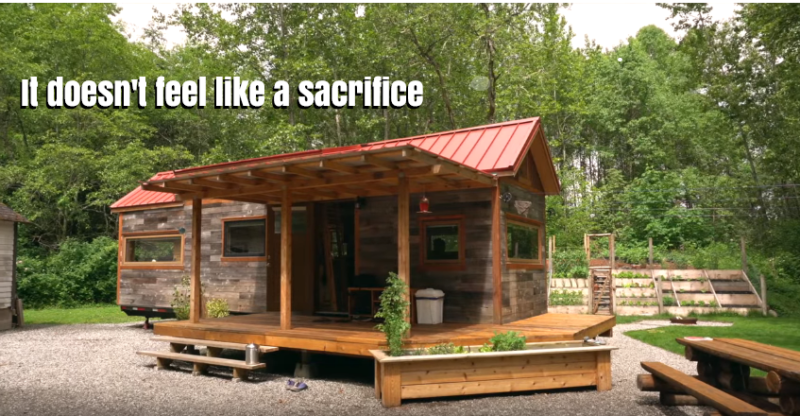
After finishing school, Jocelyn and Jarvis had $96,000 of debt from student loans, credit cards, and buying a small rural property. This is the story of how they paid it off in just 20 months, and then built themselves a debt-free custom tiny house for their family of 4.
After ignoring their finances for a long time, the couple finally faced reality one night when they sat down and added up all of their debts, and compared it to the revenue they had coming in.
When they realized how much they owed, they decided to make some drastic changes so they could pay it off and stop worrying about money. To start, they moved to a smaller apartment, changed jobs, shopped second-hand, froze a credit card in a block of ice, switched to using cash only, and made a budget that allowed them to chip away at their debt.
They had a white board with a list of all their debts, which they updated every time a payment was made so they’d continue to be motivated. After 20 months, they were completely debt-free. After that, they continued with their minimalist, frugal habits and were able to save up enough money to build themselves a custom tiny house on wheels.
They’ve been living in the tiny house for over two years now, with their two children, and plan to continue living in it for as long as they can. They are currently saving money to buy a small acreage where they will build a larger off-grid home and keep the tiny house as an income property.
We’re very inspired by this young family’s dedication to improve their lives by paying off their debt, by their awareness of their energy consumption, by their efforts to buy less and live a low waste lifestyle. They’re trying to make positive change in every aspect of their lives, and that’s not always an easy thing to do.
Thank you, Jocelyn and Jarvis, for sharing your story with us! And for the beautiful day we spent at your place! Thanks for watching! Mat & Danielle
…

Backup batteries? Got ’em. Mobile charging stations? Check. But I need a mobile battery that will keep my beer cold and charge my phone and laptop all day when I am in the field — my off-grid field that is.
River, by EcoFlow, checks all the boxes.
It’s not what you’d call practical, at least not in the sense that you can stow it in a pocket or backpack. After all, it’s about the size of a car battery and tips the scales at a whopping 11 pounds. But there’s no denying its utility. A single top-up takes about six hours via wall charger (or nine hours by car charger) and lasts a year. Once charged, River can supply a total of up to 500 watts to 11 devices simultaneously.
This mobile battery has a ridiculous number of ports. You’ll find two USB 2.0 Quick charge ports, two regular USB ports, two USB-C ports, two AC outlets, two DC outlets, and one 12V car port. The 114,000mAH battery is also smart enough to regulate voltage, giving each device precisely what it needs without going all Note 7 on us.
For the outdoorsman, there’s even a River foldable solar panel ($299) capable of fully charging the power supply in 10 to 15 hours (dependent on weather). It’s also water resistant with an IP63 certification. That’s not quite up to modern smartphone standards, but it can handle the occasional splash.
With a battery this reliable and any top quality solar panel I really can go for days without needing a Utility supply. I still need to be careful not to waste power – turn the laptop and phone off when not in use, but its a case of swings and roundabouts. The freedom is worth the extra hassle.…

This amazing 360 degree work (only a part shown) by van-dwelling artist Emily Lamb is the product of her time in jungles and mountains around the planet. She calls it “My wake-up call to re-invent ourselves in nature and our relationships with all sentient beings on this planet.”
Having thrown herself into the monumental work for months – “Now I want to backpack — go with a little money in my pocket and see how people are living,” she said after her recent show ended.
“We charge as a species into a consumer driven and frenetic future. It takes a silent and new army of the common folk, the new brave folk, the new outspoken folk, to protect whats left and what can still become. This is what i believe in, and this is how each brush stroke bled it’s colour, and each image came to life. ”
Emily, grand-daughter of the legendary wildlife conservationist and artist David Shepherd created the installation consisting of 10 x 80 foot painted canvasses, depicting scenes of wildlife and humanity around the world. Her late grandfather described her as “…someone who lives and breathes nature and who inspires others to become advocates for conservation.”
She had hired a huge industrial space to make the work “I always wanted a big space — gas heaters and two pairs of gloves and down jackets…… If am I a snug cosy place I just fall asleep.”
Now Emily is moving on – out of her space in Cornwall next week to go on the road in her van, a VW Transporter. She is not entirely happy with her accommodation.
“I cant stand in it and I cant cook properly, “ she told me. Later this year she hopes to customise a much larger vehicle for a tour of Europe. She wants a 3.5 tonne Mercedes Vario – the biggest vehicle you can drive “without having to get a truck license”
“I am nomadic by nature,” said the 32 year old who grew up in Surrey but broke free from the suburban lifestyle.
“it all made sense to slot in. But now I have done my last exhibition in that traditional space and I’m taking walks on the cliff and thinking where am I going to next – if you are open then things come your way.
“Artists by nature scavenge and gather.”
You can see more of Emily’s work here – https://www.emilylamb.co.uk/paintings/ …

Wow, that is my first thought about Atli and how she lives! She is a part-time bus driver, she can afford to work part time because she doesn’t have rent or other major housing expenses. Before Atli started her mobile life, she noticed a few other fellow bus drivers living under a bridge next to where they all worked, they lived in vans and were actually teased about being the “trolls under the bridge”, but instead of joining in on the good natured teasing, Atli decided she wanted to be one of those trolls.
Atli purchased and with the help of her dad, converted a commercial looking van into her home. I love that her dad helped her in this, that so reminded me of my dad, even the pictures of Atli’s dad made me think of my dad, it is so very sweet.
The van is very non-descript, she can park it anywhere and not draw attention, something that helps keep her safe, no one is going to pay attention to what looks like any ordinary commercial van, she purposely kept that appearance by not installing windows on the sides and by building in a bulkhead with a small door just behind the front seats. That also helps with privacy.
With the lack of windows, Atli felt that she needed to have some natural outdoor lighting so she installed a skylight right above her bed in the back, this not only gives extra natural light, she can look at the stars from the comfort of her bed. Atli also installed 2 roof vents, one has a fan, the other does not, this helps with ventilation, especially in the warmer more humid times of the year.
The van is fully insulated, not only to help keep the temps more enjoyable, it also keeps down condensation from the inside metal surfaces. Atli used a lot of wood in her van, personally I would have not used the tongue and groove wood as it does add a lot of weight, I would have preferred a lighter (weight) paneling, maybe something that had a light colored finish, but that is merely my opinion, everyone has their ideas.
I LOVE LOVE LOVE how much room she has inside this van, it’s not cluttered or crowded at all, she can fully stand up and walk around, there is plenty of storage and she can cook real meals on her 2 burner cook top. There is running water and a sink, cleverly made from a stainless steel bowl purchased from a dollar store. There is a pull out table with lots of room for eating or working, it fully retracts under her bed, a design feature that I find very handy.
The only “lack” in this setup is a bathroom facility, no toilet and no shower, things that Atli doesn’t require because she is able to …

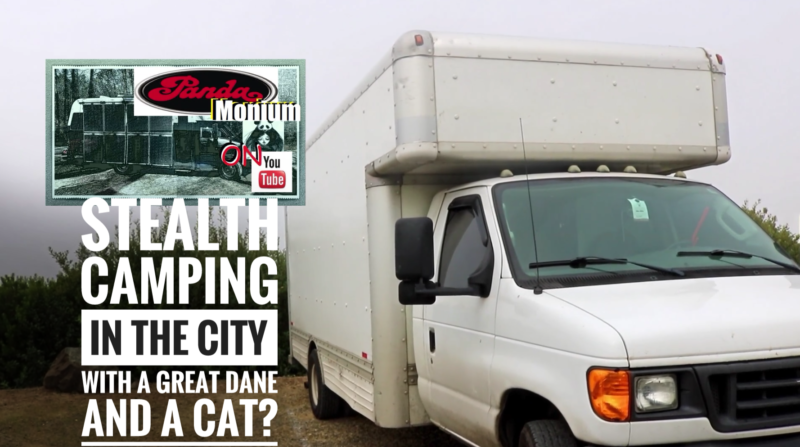
Most of the people I know of who live in their vans or other vehicles are travelers, they camp, they don’t tend to live in the city, not so for Jay, he lives in a retired U-Haul truck with his cat and a great dane! Yes, I said a great dane, as large as those tend to be, it’s apparently not too big for this conversion.
I like how Jay did his conversion, he kept everything very simple, which kept the weight as well as the cost at a minimum. Though the weight was much less of a factor since he used a commercial moving van as the base, it’s meant to carry a lot more weight than standard build vehicles.
I have always thought that U-Haul moving trucks would make a great camper van, they have plenty of power, they have lots of space, the kind of space you can use to create your own personalized living space. The other nice thing about the U-Haul (commercial style) trucks are they are inconspicuous, you will not draw much attention, especially if it’s painted white, it will blend in with any other commercial vehicle in the city.
Jay does in fact use his van as a delivery vehicle, so he is actually driving it around town, he left a space between the back roll up door and the inner wall/door so that he can place the items he delivers without showing that he is actually living inside his vehicle, and when he’s not using it in town, ie in a safer place, he can leave the roll up door open and use that space as a porch.
I was a bit surprised to find that Jay needs 2 air conditioners to keep the box cool, mainly for his animals, but only during the hottest part of summer, I wonder if he could add any more insulation, especially to the roof area, that might help keep the box from overheating and help keep in the cool air.
Watch and enjoy, let me know if this is something you would like to do, I’d be curious to know how you would implement this.
…
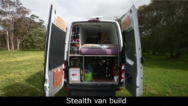

Could you live in a van? I could if I had this one, it’s designed to be a “stealth van”, it has loads of space and the space is used in a most logical and efficient manner. I like that it is tall enough to comfortably stand, even for the taller chaps. It does have a bathroom, as of the time of this video, the bathroom only contains a toilet, but it will eventually contain a shower.
The video briefly shows and explains the following features of their van:
-Garage and storage area
-LPG storage box
-Bedroom
-Natural light and ventilation
-Benefits of a ‘stealth’ style conversion
-Kitchen and dinette area
-Overhead storage cabinets
-Bathroom and toilet area; and
-Battery storage and supply (lithium phosphate)
https://youtu.be/J7dgPL0ZNbw
…
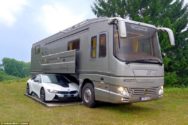
The Volkner mobil performance s is the future of road living. The 40ft luxury motorhome comes with all of the mod-cons you could possibly wish for. However
you may need deep pockets to purchase one. There is no doubt that this mobile home has the super wealthy in mind. With a price tag of $1.7million (£1.2million) it is out of reach for most people, but it never hurt to dream.
The Performance S also offers a fully-equipped kitchen, sleeping quarters, wooden and leather fittings, state-of-the-art entertainment, and a wall that slides out to provide extra space.
Stephanie Volkner, director of German firm Volkner Mobil, says one of the greatest features that shows off the home’s lavishness is a cooking island, something that cannot be found inside most of the motorhome’s competitors. Going on to say “It is a house on wheels”.
Customers can choose from a range of fixtures and fittings to customise their motor homes to their preferences. With high-quality leather seats to real wood units and stone tiles in the kitchen and bathroom on offer. It even includes a supercar garage fitted with a electrohydraulic lift. So, if you happen to own a Ferrari, Porsche, BMW or Mercedes, You can bring it with you on your travels.
Volkner also says ‘Our clients normally have big companies. They want to travel freely.
‘They want to decide when they start their journey, where they can go, not before. ‘They look at the weather and start. They want to live in their own, very personal area. Exclusive is for everybody very different. Some need a golden faucet to be exclusive.
‘For me, it’s exclusive that the interior has harmony and all the materials are of the highest quality and their processing is at the highest level.’
Would you buy one if you had the cash ?
Find more luxury mobile homes here: https://www.billionaire.com/luxury-mobile-homes/1659/the-best-luxury-mobile-homes-
Looking for a cheaper alternative? Read: https://off-grid.net/mobile-homesteading/…


I had so much fun watching this couple condense a 30 day conversion into a short video, as I saw each part, I thought that’s just how I would want to do it myself! I am not familiar with a “Sprinter Van”, but it’s a wonderful size for this purpose, it’s compact enough that parking will not be a problem, it is not going to look like people are camping or living in it, so it’s perfect for stealth camping in town. It looks very presentable, from the outside it looks like just a normal van, nothing that would draw attention.
Being smaller, it does not have any sort of bathroom facilities, no dedicated toilet, no shower area, but it does have everything else one would need. I love the couch that converts into a bed, the design for that is so ingenious, it is well insulated. The kitchen looks great, I LOVE the deep sink, so often in van conversions, the sink tends to be very undersized, especially in the depth, this sink does not have that issue. The tiles look good, but that is the one area I would have deviated, mainly because of the weight it adds and it’s not flexible, I wonder if it will eventually crack or tiles start popping out, hopefully not, but with all the movement, vibration and flexing, I don’t have much faith in it to maintain integrity.
The way they permanently mounted the Vitamix mixer is ingenious! It looks great, will not move around and is usable in place. The rest of the kitchen is equally well done. Watch the videos and enjoy, the first video is an overview, if you want to see more details, watch the rest of the videos in the series.
…

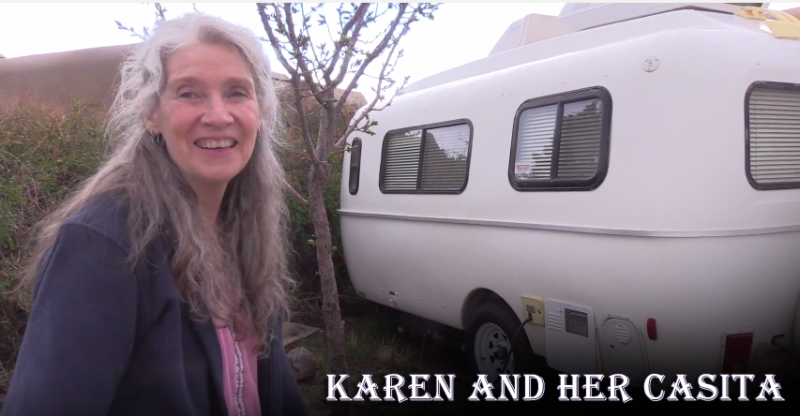
I spent some time today listening to Karen describe her life and how she ended up living in a small Casita travel trailer. I am wowed by her story, she has lived a very interesting life, has experienced both the good and the bad, and she has a nice story telling style that is easy to listen to (as well as watch)…
The Casita is a relatively newer style of fiberglass travel trailer, instead of being made with a metal skin, there is nothing to rust or bend out of shape. I suspect they don’t have the leaking problems that other travel trailers have, my friend Beth who has lived in various travel trailers and RVs can attest that the older style units have a propensity to leak, and often in the worst place, usually right over your bed in the middle of the night.
Karen shows how has customized her Casita for her life, it looks roomy and comfy. She is one of a growing population of single ladies living a mobile life, some might call her fearless, I see a sensible lady with lots of experience and enough know-how to not be intimidated by anything.
Enjoy the videos
https://youtu.be/aNz_6-YfrGc
…
“Living in a van, I can make money, be an artist, and travel three continents,” says Nathan Murphy, an accomplished amateur rock climber from Cornwall in the UK, who has spent the past two years fitting out and then travelling in his Ford Transit.
With the number of van conversions and purpose built motor homes at an all time high, what used to be a tiny subculture is going mainstream. The mobile life is no longer seen as a family vacation option. Improved technology, better camping gear, mobile phones and the internet mean it just as viable long term as owning a bricks and mortar home.
We have written about Nathan before, but recently he was featured in The Sun newspaper, and that was a reminder at how mainstream the lifestyle has become.
These days, retirees and students are just as likely to be buying a recreational vehicle if they can afford it, or converting a small van if they are on a budget. From snowbirds (the retirement generation seeking the sun) to snowflakes (as thin-skinned millennials are sometimes known) there is a growing realisation that a McMansion has too many overheads that eat into your freedom.Van living is a way to “make your life cheaper so you can do more with less.”
“Why engage in a system that is broken?” says Nate in an interview on the off-grid youtube channel. “I just don’t want to waste my entire life paying the bank interest.” There is a housing crisis affecting the generation that are leaving college now – because not enough homes are being built, and scarcity is keeping prices too high. “More and more people are choosing a different option,” says Nathan. “There are hundreds of thousands of people across Europe looking at alternatives – tiny homes, off-grid, van living. Its a huge trend.”
He was brought up in a big old house in Cornwall that needed constant works – which gave him the skills he uses van living.
“I can do a huge amount for very little money,and my rent is zero. I can do so many things that most people don’t dare to do – I just want to show people they can do it all,” by reducing their living costs to nearly zero, meaning they no longer need to be wage slaves.…